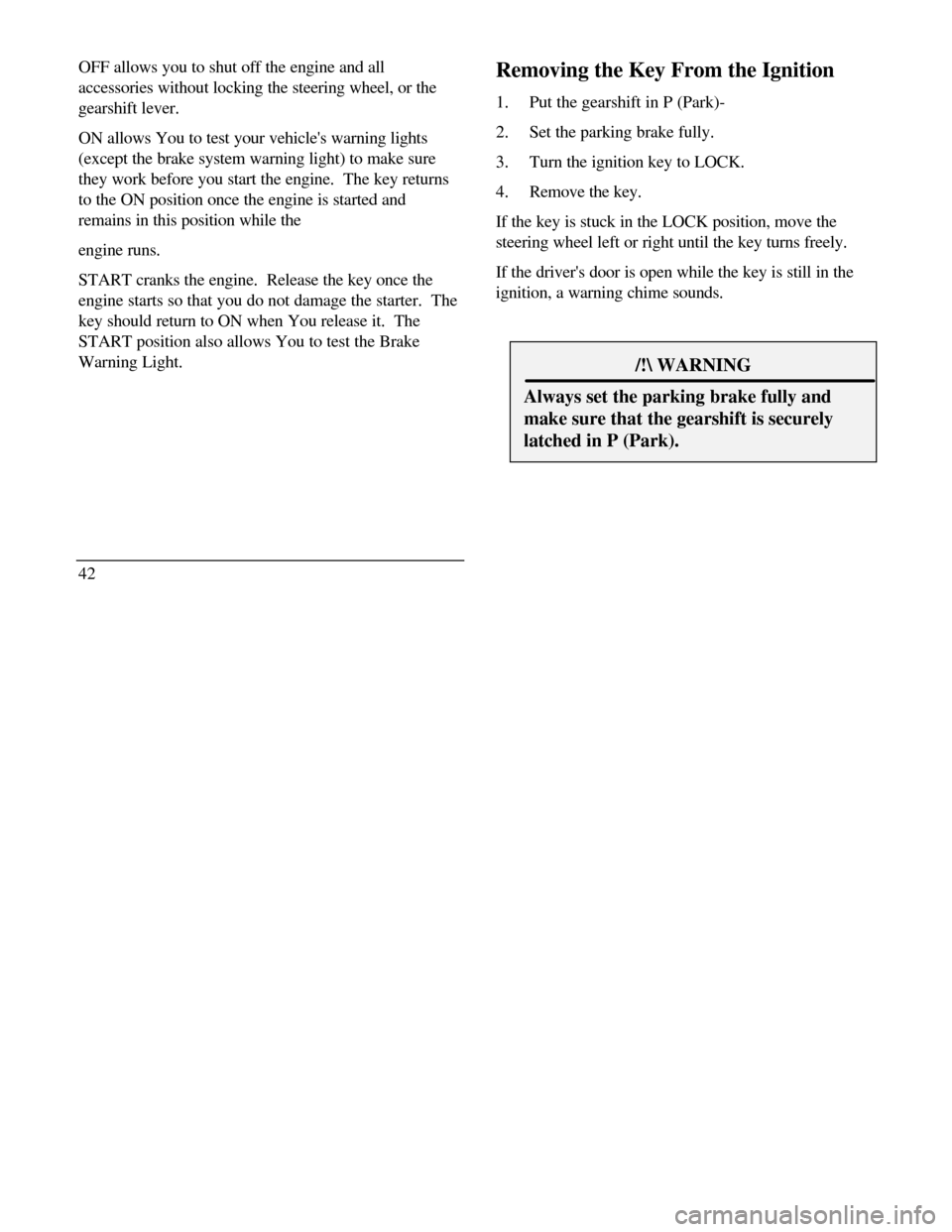Page 37 of 320
Setting the retractor to automatic locking
mode6. Allow the belt to retract. A clicking sound will
be heard as the belt retracts. This indicates the
retractor is in the automatic locking mode.
Pull on the lap belt portion across the child seat
towards the buckle and continue to pull up on
the shoulder belt portion while pushing down
on the child seat allowing the shoulder belt to
retract to remove any slack in the seat belt.
See Figures 5 and 6.
33
Page 40 of 320
8. Double check that the retractor is in the
automatic locking mode. Try to pull more belt
out of the retractor. If you cannot, the belt is in
the automatic locking mode. See Figure 8.
36Checking the retractor
Page 41 of 320

9. Check to make sure that the child seat is
properly secured prior to each use. If the
retractor is not locked, repeat steps 6 through
8.
NOTE:To remove the retractor from
automatic lock mode, allow seat belt to retract fully
to its stowed position and the retractor will
automatically switch back to the vehicle sensitive
locking mode for normal adult usage.
Installing a Child Safety, Seat at the
Front Center Seating Position with
Adjustable Lap Belt-
1.Lengthen the lap belt. To lengthen the belt,
hold the tongue so that its bottom is
perpendicular to the direction of webbing
while sliding the tongue up the webbing.
2. Place the child safety seat in the center seating
position.3.Route the tongue and webbing through the
child seat according to the child seat
manufacturer's instructions.
4. Insert the belt tongue into the proper buckle
for the center seating position until you hear
a snap and feel it latch. Make sure the
tongue is m securely fastened to the buckle
by pulling on tongue.
5. Push down on the child seat while pulling on
the loose end of the lap belt webbing to
tighten the belt.
6. Before placing the child into the child seat,
forcibly tilt the child seat from side-to-side
and in forward directions to ensure that the
seat is held securely in place. If the child seat
moves excessively, repeat steps 5 through 6,
or properly install the child seat in a different
seating position.
37
Page 44 of 320
Starting Your ContinentalIgnition
Understanding the Positions of the
IgnitionThe positions of the key in the ignitionACCESSORY allows some of your vehicle's
electrical accessories such as the radio and the
windshield wipers to operate while the engine is not
running.
NOTE:Your vehicle is also equipped with an
accessory timer. This allows some of your
accessories to remain on for up to I 0 minutes after
the ignition is turned to the OFF position. The
accessory timer is cancelled if any door is opened, the
dimmer switch is used, or the ignition is turned to the
ON position.
The automatic transaxle gearshift must be in P (Park)
to move the key to the LOCK position.
LOCK locks the steering wheel. It also locks the
gearshift lever.
LOCK is the only position that-allows you to remove
the key. The LOCK feature helps to protect your
vehicle from theft.
41
Page 45 of 320

OFF allows you to shut off the engine and all
accessories without locking the steering wheel, or the
gearshift lever.
ON allows You to test your vehicle's warning lights
(except the brake system warning light) to make sure
they work before you start the engine. The key returns
to the ON position once the engine is started and
remains in this position while the
engine runs.
START cranks the engine. Release the key once the
engine starts so that you do not damage the starter. The
key should return to ON when You release it. The
START position also allows You to test the Brake
Warning Light.
42Removing the Key From the Ignition
1.Put the gearshift in P (Park)-
2.Set the parking brake fully.
3.Turn the ignition key to LOCK.
4.Remove the key.
If the key is stuck in the LOCK position, move the
steering wheel left or right until the key turns freely.
If the driver's door is open while the key is still in the
ignition, a warning chime sounds./! WARNINGAlways set the parking brake fully andmake sure that the gearshift is securelylatched in P (Park).
Page 48 of 320

For a warm engine: Do not hold the key in the START position for more
than five (5) seconds at a time. If the engine does
not start within five (5) seconds on the first try, turn
the key to the OFF position. Wait a few seconds
after the starter stops, then try again.
Whenever you start your vehicle, release the key as soon
as the engine starts. Excessive cranking could damage
the starter or flood the engine.
After you start the engine, let it idle for a few seconds.
Keep your foot on the brake pedal and put the
gearshift lever in gear. Release the parking brake.
Slowly release the brake pedal and drive away in the
normal manner.
NOTE:Your vehicle is equipped with an automatic
transaxle that has an interlock that prevents you from
shifting out of P (Park) unless your foot is on the brake
pedal.If the engine does not start after two
attempts:
1. Turn the ignition key to the OFF position
2. Press the accelerator all the way to the floor
and hold it.
3. Turn the ignition key to the START position,
4. Release the ignition key when the engine
starts
5. Release the accelerator gradually as the
engine speeds up. Then drive away in the
normal manner.
If the engine still does not start, the fuel pump
shut-off may have been triggered. For directions
on how to reset the switch see Fuel Pump Shut-
Off Switch later in this chapter.
45
Page 49 of 320

A computer system controls the engine's idle speed.
When you start your vehicle, the engine's idle speed
normally runs higher than when it is warmed up. These
faster engine speeds will make your vehicle move
slightly faster than its normal idle speed. It should,
however, slow down after a short time. If it does not,
have the idle speed checked.
If the engine idle speed does not slow down
automatically, do not allow your vehicle to idle for more
than 10 minutes. Have the vehicle checked./! WARNINGExtended idling at high engine speeds can producevery high temperatures in the engine and exhaustsystem, creating the risk of fire or other damage.46/! WARNINGDo not park, idle, or drive your vehicle in drygrass or other dry ground cover. Theemission system heats up the enginecompartment and exhaust system, which canstart a fire.Engine Block Heater (If equipped)
Engine block heaters are strongly recommended if
you live in a region where temperatures reach -10° °F
(-23° °C) or below. An engine block heater warms
the engine coolant, which improves starting, warms
up the engine faster, and allows the heater-defrost
system to respond quickly.
To turn the heater on, simply plug it into a
grounded 110-volt outlet. Ford recommends that
you use a 110-volt circuit that is protected by a
ground fault circuit interrupter.
Page 56 of 320

This light comes on when the parking brake is
set, or if it is not set, it comes on briefly when
you turn the ignition to the START position. It
normally goes off shortly after the engine starts
and you release the parking brake. If the light
stays on after you have fully released the
parking brake, have the hydraulic brake system
serviced by your dealer or a qualified service
technician./!\WARNINGThe BRAKE light indicates that the brakesmay not be working properly. Have thebrakes checked immediately.Anti-Lock Brake System Warning Light
This light comes on for a few seconds when you
turn the ignition key to the START position. It
should go off shortly after the engine starts. If it
stays on longer than five (5) seconds, it indicates
that your anti-lock brake system may not be
working properly. Normal braking is not affected
unless the BRAKE system warning light also
remains on for longer than six (6) seconds. You
should have your vehicle serviced immediately by
your dealer or qualified service technician to restore
the benefits of the anti-lock feature. See Anti-lock
brakes in the Index for more information.
53